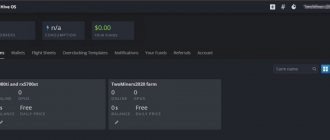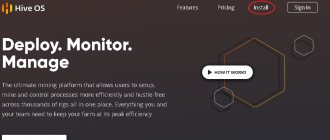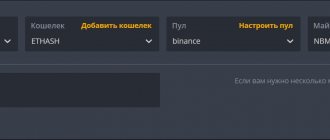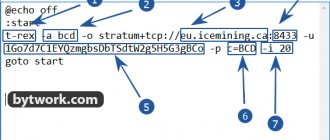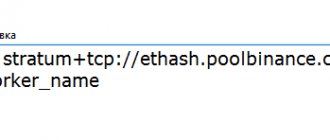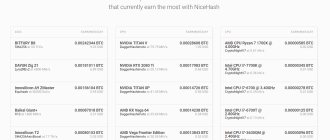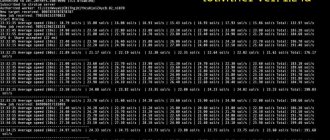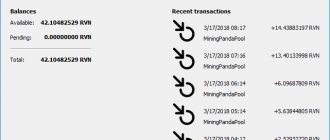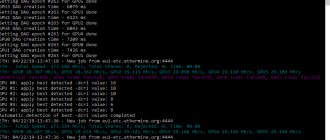Hive OS
Recently, the mining community has seen a general transition to the Hive OS operating system, which has built-in software for mining a variety of cryptocurrencies on all popular pools. Users are also attracted by the well-thought-out HiveOS web interface, which makes monitoring and administering the operation of rigs and ASICs incredibly convenient and simple processes.
The first version of Hive OS was launched in the fall of 2022, being a slightly more complex system in terms of settings than what we have today. The Hive OS distribution is available for free download, but you will have to pay for its use in mining.
Installation of this system can be done either on a hard drive in HDD/SSD format or on a flash drive. Moreover, this is done in just a few simple steps, which even a beginner can handle (if you have instructions at hand, for example, this article).
The reasons why you should choose Hive OS for mining, as well as details on downloading, installing and configuring this system, are below.
- What is HiveOS and why is it suitable for mining?
- Installing HiveOS Burning the HiveOS image to a USB flash drive
- Setting up a bootable USB flash drive
- Registration on the HiveOS website
What is HiveOS and why is it suitable for mining?
What is Hive OS
Hive OS
(Hive OS)
is an operating system from the Linux family (based on Ubuntu) designed specifically for use in cryptocurrency mining. It contains many software solutions that greatly simplify the process of setting up and controlling cryptocurrency mining on popular GPU devices (farms and ASIC miners).
Thanks to HiveOS, there is no need to alternately connect video cards (those who mine on Windows know what we are talking about), download, install and update various mining software and drivers, as well as edit many bat files.
This system supports work with Nvidia and AMD graphics accelerators, is not demanding on the resources of the hardware used (2 Gb of RAM is enough) and can work stably even with old AM2/774 sockets. At the same time, up to 19 video cards can be installed in one rig.
☝️
The main feature of HiveOS, which makes it an ideal system for mining, is remote control in real time through a convenient web interface.
Moreover, control can be both global, that is, over several rigs at once, and point-wise, over individual farms or video cards.
Features of using HiveOS
The list of tasks that can be performed in this way on Hive OS is simply impressive:
- View equipment performance data;
- Setting energy consumption parameters;
- Overclocking video adapters;
- BIOS firmware (for AMD cards);
- Creating a schedule for automatically turning on/off and rebooting rigs;
- Quick reconfiguration for mining other coins, etc.
All this is very convenient, especially when it is not possible to physically be near the equipment in order to solve problems that arise during the mining process.
☝️
But there is also a downside to the coin - in most cases you have to pay to use Hive OS (exceptions will be described below).
True, this fee is quite symbolic, given the list of capabilities that the user ultimately receives.
Where to download HiveOS
Downloading HiveOS
It is recommended to download this operating system only from the links posted on the official HiveOS website in the “Install” section.
HiveOS official website
Proceed to download HiveOS
Among all the options available here, you need to select an OS image suitable for the user’s equipment - for ASICs, GPU rigs or AMD Vega video cards.
In our example, we will consider installing Hive OS on a rig, so we choose to download the stable version of the client for the GPU via torrent or as a zip archive (weighs 1.8 Gb).
In addition, you need to download a utility that will be used to write installation files to a flash drive.
Hive OS builds available for download
Clicking on the “Hive OS Drive Flashing Utility” button will take you to GitHub, where you need to scroll down a little and click on the “Download hive-flasher image from” link.
Proceed to download the flash utility for recording Hive OS
In the list that opens, you need to select and download a version of the program that supports recording the downloaded image - in our case (for a GPU rig), Etcher is suitable.
List of utilities for recording a HiveOS image
Installing HiveOS
Hive OS installation process
How to install Hive OS:
- Unpack the system image.
- Write it to a flash drive.
- Make the necessary settings in the files on the flash drive.
- Connect a flash drive with Hive OS to the farm.
In fact, installation in the usual sense of HiveOS is not required - a ready-to-use system image is downloaded from the website, which needs to be written to a flash drive and then made a few settings. Details of this process are presented below.
Burning a HiveOS image to a USB flash drive
After completing the necessary downloads, you need to use standard system tools to unpack the archive with the HiveOS image and create an installation flash drive with it.
Unpacking the archive with the HiveOS image
Since the resulting file weighs 7.5 GB, to record it you will need to connect a flash drive with a memory capacity of at least 8 GB to any free USB port of your PC. Next, you need to run the Etcher program (no installation required, since the version is portable), click “Select image” and select the unpacked Hive OS image.
Selecting a Hive OS image in the Etcher application
After this, the flash drive connected to the computer will be automatically detected by the program and all you have to do is click the “Flash!” button to write the Hive OS image to it.
Starting to write a HiveOS image to a USB flash drive
When Etcher reports the end of recording, the flash drive must be removed and reconnected to the PC so that it is re-identified in the system.
Setting up a bootable USB flash drive
In order for the created flash drive with HiveOS to function correctly, you need to go to it and open the rig-config-example.txt
.
Opening a file with Hive OS settings
In the existing text you need to find the line FARM_HASH
and after the equal sign, insert the value that is in the farm settings in the user account on the HiveOS website (registration details there are in the next section).
Hive OS starting settings
Next, changes in the file need to be saved and renamed to rig.conf
. At this point, the creation of a bootable USB flash drive with Hive OS is completed and it can be connected to the farm.
☝️
Important! If the rig is connected to the network not via an Ethernet cable, but via a WiFi adapter, you also need to edit the wifi.txt file on the flash drive in the network folder, writing in it the name of your wireless network and the password to access it.
HiveOS settings for connecting the rig via Wi-Fi
HiveOS registration.
The first thing you need is a USB flash drive or USB disk with a capacity of at least 8GB . In this case, a USB disk (HDD or SSD) will be preferable, because USB flash drives are not designed for a large number of write cycles and tend to die within the first year of use as an operating system carrier.
Tip: When HiveOS crashes, it happens that the system does not find the boot disk. This does not always mean that you need to rewrite the flash drive. It is enough to simply turn off the power to the entire rig and wait until the LED on the flash drive stops blinking. After rebooting, HiveOS will work again.
For comparison, Windows 10 requires 20GB plus 16Gb for the page file. In addition, Windows 10 requires more RAM, a more powerful CPU, and the graphical interface takes up a significant 700MB of video memory, which is very important for some mining algorithms (Ethash).
Installing HiveOS is also possible on the system drive, but it is better to leave it under Windows to be able to mine new cryptocurrencies that are not yet available on HiveOS.
And so, if you already have a storage device of 8GB or more, go to the HiveOS website to register and download the operating system image.
When registering, enter the Promo code CRYPTOAGE to receive a bonus of 10 USD to your account.
Setting up Hive OS
Features of setting up HiveOS
How to set up HiveOS:
- Register on the Hive OS website.
- Use the Farm Hash parameter to configure the bootable USB flash drive.
- Configure the worker.
- Create a new wallet in your account.
- Put together a cryptocurrency mining scenario (flight sheet).
- Start the mining process.
- If necessary, edit the equipment performance settings.
Details on how to complete the steps listed are provided below.
In the described process of creating a bootable flash drive, some of the settings necessary for using HiveOS on a mining rig have already been made.
In fact, after connecting the flash drive, the farm is ready to go. You don’t even need to connect a monitor to it to perform any actions, since the remaining settings are made exclusively through the miner’s account on the Hive OS website.
That is, the next stage is account registration. Moreover, in order not to waste time, this can be done in parallel
with the process of downloading the system image and burning the flash drive.
Registration on the HiveOS website
To start registering, you need to click on the “Sign In” or “Start Mining” button on the main page of the HiveOS website.
Starting registration on the Hive OS website
In the registration form you need to fill in only three required fields - email, login and password. You can also enter the inviter’s promo code (if you have one) to receive a bonus $10 on your balance by clicking on the “Have a promo code” line.
Registration form on the Hive OS website
The usual confirmation of the specified email address is not required. Therefore, immediately after clicking the “Register” button, the user’s personal account window opens.
When you do this, a notification appears asking you to enable two-factor authentication by scanning the QR code or copying and entering the code in the Google Authenticator mobile app.
You can skip this step if you wish, but you will still need to complete it in the future to fully use the site.
Connecting 2FA on the Hive OS website
Setting up a miner account
In your account, the first thing you need to do is click on the square with the name of the farm and go to settings to copy the value of the Farm Hash parameter.
First action in the new HiveOS user account
This is exactly what we needed when completing the preparation of the installation flash drive described above.
Farm Hash parameter required to create a bootable USB flash drive
Immediately after turning on the farm with the connected flash drive, it should appear in the miner’s account on the “Workers” tab.
List of rigs connected to the account on the Hive OS website
Clicking on the name of the rig opens a page with a list of video cards available in it, suitable for mining cryptocurrencies, and detailed information on them - name, power, temperature, etc. Below you can see the general parameters of the rig - RAM, power consumption, processor , version of HiveOS used, etc.
Overview of the contents of a farm with HiveOS installed
All parameters necessary for mining on detected equipment are set automatically by the system. But if you wish, in the “Settings” tab, you can manually change the name and description of the rig, the worker password, the number of video cards used, the miner start delay and other technical issues.
All data changed in this way over the network is synchronized with the user’s farm and will be entered into the same rig.conf
, which we configured after recording HiveOS onto a USB flash drive.
Worker settings on the Hive OS website
Before proceeding directly to the mining process, you need to create a new wallet in the tab of the same name, indicating the cryptocurrency it is intended to store, its address, an arbitrary name and source (exchange, pool, etc.) .
At the same time, you can activate the option to use the created wallet as a global one (for all farms connected to your account) and display its balance.
Creating a wallet for mining using HiveOS
The next step is to create a so-called flight sheet in a tab with the appropriate name. Essentially, this is the scenario on which the farm’s cryptocurrency mining process will be based. You will need to indicate:
The coin you are going to mine.
Wallet for crediting rewards (created above).
Mining pool.
Miner (software through which cryptocurrency mining will be carried out).
Flight sheet name.
The last parameter is arbitrary, but it is better to register the coin and pool here if there are several mining farms and processes in the HiveOS account, so as not to get confused in them.
Creating a flight sheet on the Hive OS website
Then all that remains is to return to the configured worker and, finally, start the mining process by clicking the rocket-shaped button located on the top panel, selecting the created flight sheet when prompted. After 1–2 minutes, data on the performance of each video card and the farm in general will appear in the overview window.
Starting mining via the HiveOS web interface
If the obtained performance indicators are not satisfactory, you can manually edit the settings of the video adapters used (core and memory frequency, fan speed, power consumption limit, etc.) through the overclocking tool (button in the form of a dial with an arrow).
Overclocking a video card using Hive OS tools
Using these manipulations, you can increase the hashrate of a rig running Hive OS by 1.5–2 times.
The result of overclocking video adapters via HiveOS
Also, if desired, in the “Schedule” tab, you can configure the execution of automatic actions, for example, applying an overclocking template, shutting down or rebooting the farm. In this case, you need to select the flight sheet to which the schedule is applied, the command to be executed and indicate the schedule for its execution.
Create a schedule for Hive OS automated actions
Another useful Hive OS tool is watchdog, which monitors the drop in hashrate and, if necessary, restarts the miner or reboots the equipment. It is activated using the button with the dog symbol located on the panel at the top of the site.
Hashrate watchdog on the Hive OS website
At this point, the HiveOS setup can be considered complete. All that remains is to understand the terms of payment for using the system and, if necessary, make a deposit to cover expenses in the near future in order to prevent the mining process from stopping due to a negative balance.
Watch detailed video instructions for setting up HiveOS:
Instructions for setting up HiveOS
Setting up HiveOS to get started
While the image is being written to disk, go back to the HiveOS website and go to your personal account.
First you need to create a new farm; for this there is a “PLUS” button in the top menu.
After creating a new rig, it will appear on the main window, go to its settings.
Already in the rig settings window, we also click on the “PLUS” button in the top menu, where we select “Add worker”
In the worker creation menu, select a GPU or ASIC device, come up with a name and password. The remaining fields are optional.
After creating a worker, you will see data on the worker: Farm_Hash, RIG_ID and RIG_Password. This data is necessary to identify your rig. And they need to be written to a flash drive that you created using the Etcher program.
We go to the created HIVE disk on the USB flash drive, after downloading the RIG.CONF file. Downloading this file is available after creating a worker.
The RIG.CONF file must be copied to the “HIVE” flash drive in the root directory of the flash drive.
You can skip this step, but instead, when you first start HIVEOS, you will have to enter RIG_ID and RIG_PASSWORD to activate the system.
Do I have to pay to use Hive OS?
Payment for Hive OS
☝️
Users who have only one worker in their account do not need to pay for HiveOS.
Also, the system can be free for those who have from 2 to 4 rigs if they are engaged in mining:
- Ethereum through the Hiveon pool (Hive OS’s own pool of developers);
- Other coins on any pools.
But when mining ETH on other pools, only the first rig will be free, and for the 2nd, 3rd and 4th you will be charged $3 per month
.
If there are 5 or more workers, then you will have to pay for each of them, regardless of which pool is selected (at the same rate - $3/month). Or you can do without depositing your own funds into your account balance, set up Ethereum mining through Hiveon, and instead of paying for HiveOS, give the pool a 3% commission on your rewards. By default this option is enabled, but it can be disabled in the rig settings.
Enabling payment for HiveOS through the Hiveon pool
As for the standard payment method ($3/month), previously billing was calculated for each day of using Hive OS, regardless of how long the workers worked during the day.
☝️
Now, pricing has become more fair - rig activity is checked every 5 minutes and invoices are issued only for the time when HiveOS was actually used for mining.
Users who do not wish to mine on the Hiveon pool at preferential terms must deposit enough funds into their account to cover the cost of using Hive OS on their farms. This is done through the “Your Funds” menu in the main account menu using the CoinPayments payment system.
Top up your balance on the Hive OS website
To prevent mining from stopping unexpectedly, there is a 5-day credit system. This means that the balance can become negative, but if there is no deposit to cover the debt on the 6th day, cryptocurrency mining through Hive OS will be stopped.
The deposit can be distributed among existing rigs. Although this is not necessary, payment for the use of HiveOS by workers will automatically be charged from the main balance.
You cannot withdraw funds from your account, but you can send them to other users. Even more details on billing when using Hive OS are available here.
Hive OS and Nicehash
Mining in Nicehash
Despite the fact that Nicehash is in fact not a pool, but a platform for buying/selling computing power, HiveOS still works with it. The system contains all the templates necessary for this.
☝️
Read the full article:
To use Hive OS in conjunction with Nicehash, you need to create a new flight sheet, in which, when selecting a coin, the word “nice” is written in order to see all the available hashing algorithms for this service.
Next, you need to add a new wallet, specifying in its parameters the BTC address from your account on the Nicehash website (it will be used for all coins and in the algorithm you need to select the same service.
Creating a wallet for Nicehash
It is clear that we also indicate Nicehash as a pool, choosing a server suitable for geolocation. The last thing left to do is to select a miner and configure it.
You will need to specify a wallet (the same BTC address as above) and a worker, select the type of video card (AMD or Nvidia) and register the pool server, port and password. All this data can be found in the user account on Nicehash.
Setting up a miner to use Hive OS in conjunction with the Nicehash service
After this, you can save the new flight sheet and safely launch one of your rigs (or all at once) running HiveOS under its control.
Setting up HIVEOS to start mining cryptocurrencies
We have already taken the first step in creating a worker to obtain the RIG.CONF file, then all that remains is to configure Wallets, Flight Sheets and select the optimal settings for video cards.
Immediately after creating a worker, you need to create a Wallet for each cryptocurrency that you will mine.
In the following example, we consider setting up a GPU rig on HiveOS for mining the popular cryptocurrency ETHEREUM. Similar actions will be relevant for all other options.
In the main menu of HiveOS, where there is a list of all your rigs, look for the “Wallets” menu, go there and create a new wallet. “Add wallet” button in the right corner.
By creating a wallet from the main menu, you create a global wallet that will be valid for all mining rigs, and not for one, if the wallet is created already in the menu of one selected rig.
Next you need to select “Coin” or cryptocurrency. Specify the address where the mined coins will be sent. For storage, it is better to choose local wallets or large cryptocurrency exchanges, such as Binance.
The name of the wallet is a choice of name at your discretion. For Ether, it can be called Ethereum.
The source is not required, nor is the API key.
It is advisable to turn on the “Get wallet balance” switch for your convenience. Because The account balance will be shown immediately in HiveOS, making it easier to monitor the final result of mining.
The next step is to create a Flight Sheet .
The flight sheet is the final configuration option for HiveOS to start mining. Flight sheets, as well as wallets, are global for all rigs and individual for specific rigs. Create a flight sheet in the main menu to create a global flight sheet for all rigs at once.
Coin — select the cryptocurrency for which the flight sheet is created. Choose ETH.
Wallet - select the wallet created in the previous step for the Ethereum cryptocurrency.
Pool - select a pool for mining; it is advisable to choose from supported pools for ease of setup.
For Ethereum, we chose the Binance Pool. Before you start working with this pool, you need to register using this link.
Select Binance in the Pool window and a server selection window appears. Select EU Server and click “Apply”. You don't need to configure anything else.
Miner - select a program for mining. For Ethereum, select Phoenix. Some miners, like Claymore, suggest using double mining, i.e. mining two coins at once. Therefore, for these miners you can use additional settings windows, which we will not touch on now and will simply skip. Because Such operating modes can lead to rapid equipment failure and for novice miners it is better to avoid them in the first stages.
Additional settings for miner, if you have selected a pool from the list of supported ones, are not required . Therefore, the miner settings menu may be required only in rare cases when the standard settings are unstable.
Click on the “Create flight sheet” button.
Now everything is ready to launch your first mining rig on HiveOS.
Go to the created RIG in the Workers .
Check that the system sees all video cards (in our case there are 4 of them), and the system’s power consumption is already shown. Below, the worker we created called GRIN should not have a white WI-FI icon with an exclamation point. Otherwise, your GPU RIG is not online and you will not be able to control it.
If your rig is still offline, then connect a monitor to the rig and check that the system boots and does not require a password upon first login. If HiveOS does not boot, you need to go into the motherboard BIOS (DEL button during boot) and install boot from USB.
Ideally, you will see a picture similar to the one in the screenshot.
To start mining, check the box next to the rig (for us it’s GRIN). After this, a control panel will appear in the upper right corner.
Click on ROCKET
Next, select the flight sheet
After a minute, we refresh the page in the browser and get a similar result:
The main menu of the rig shows the energy consumption and hashrate of the entire rig during mining.
Now you can go to the selected pool and check that the hashrate is shown there too.
This is where we can finish the main part about how to set up HiveOS for the first time.
Next, we will talk about the main features of using HiveOS, which is why everyone switches to this OS.

